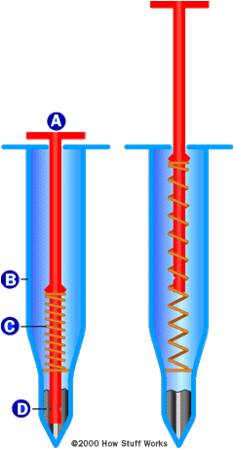"Do you rely on those plastic pop-up thermometers in your chicken?" I was asked this question the other day by an acquaintance who found out I cook professionally. My answer was no. I rely on my instant-read thermometer because in my experience the pop-up thermometer yields a dry, over cooked bird. I decided to do a little research on the pop-up thermometers we find lodged in the breasts of those grocery store roasters. (graphic on the left courtesy of How Stuff Works. )

I found out that the pop-up indicator stem (A) is anchored by an alloy (D). When the alloy melts, it frees the stem, so the spring inside (C) pops the stem up letting you know the bird is done.
This is certainly a neat invention. Unfortunately, the alloy melts at approximately 175 degrees.
This means that little plastic contraption is letting you know your chicken is done when the breast meat is 175 degrees. This means the thigh meat is around 185 degrees.
The USDA guidelines related to safe cooking of poultry read that all poultry should reach a minimum internal temperature of 165 degrees.
When roasting any kind of meat, you need to account for carry-over cooking. Carry-over cooking refers to the phenomenon that food retains heat and continues to cook even after being removed from the source of heat. The larger and denser the object being heated the greater the amount of carry over cooking. After being removed from the heat source (oven, grill, etc.), the internal temperature can continue to increase 5-10 degrees or more depending on the size and cut of meat. Imagine if you take your roast chicken out of the oven at 175 degrees. By the time you let it rest while making your pan sauce, there is a distinct possibility that the meat reaches nearly 185 degrees by the time you serve it. Yikes! You may as well serve shoe leather.
Do yourself, your family and your dinner guests a favor. Invest in an instant read thermometer I like the Thermapen 5. They aren't cheap. Depending on the model you choose, they run $70-$95, but it is quick and accurate. If that price is too steep, there are plenty available on the market for less. You should look for one that has a probe over 2 ½ inches long, a quick read-out on a large, easy to read dial or digital display and ideally one that has a calibration option.
Armed with this new piece of equipment, when you roast your next chicken my advice would be to take queues from Barbara Kafka "Roasting - A Simple Art" and Judy Rodgers "Zuni Café Cookbook" and roast your bird at 450-500 degrees. Depending on the size, efficiency and accuracy of your oven, and the size of your bird, you may need to adjust the heat to as high as 500 or as low as 450 during the course of roasting to get the chicken to brown properly. Cook the bird until it is done which may be from 45 minutes to 1.5 hours depending on the size of the chicken. figure approximately 10-15 minutes per pound for an unstuffed, whole chicken. And remember, you are looking for a finished temperature of 165 degrees, so take it out a few degrees before the target temperature in the thickest part of the thigh.
One note, make sure you do this high heat roasting in a clean oven, otherwise you may end up with a smoke-filled kitchen and even worse, a blaring fire alarm!
Enjoy!

